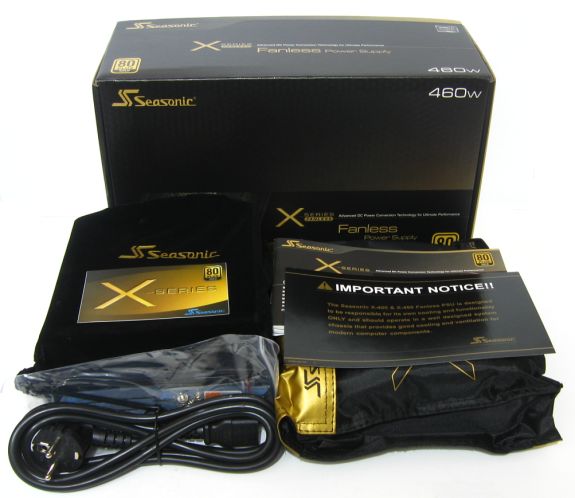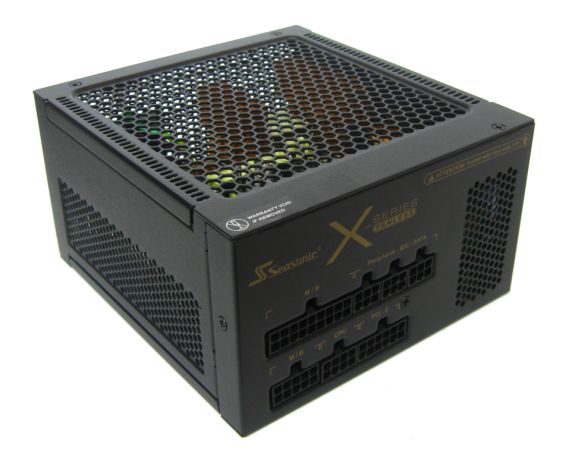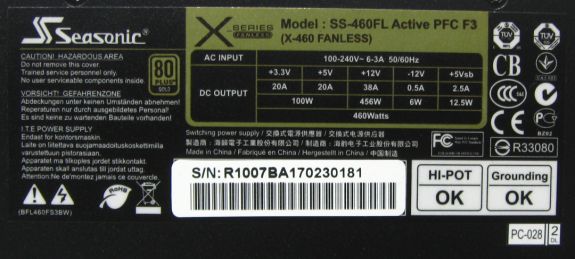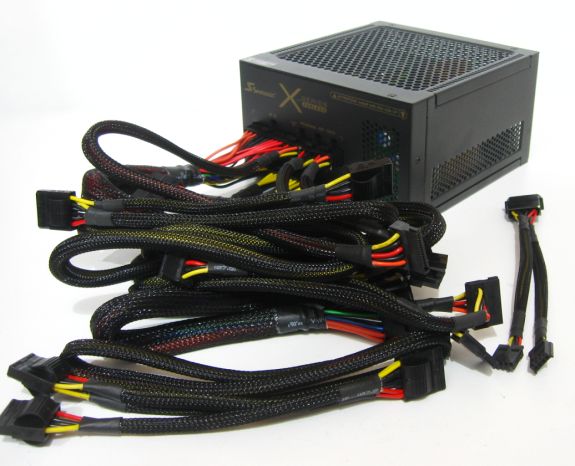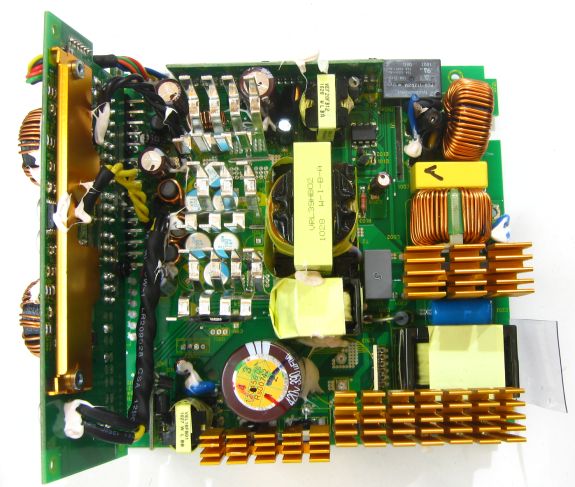
Original Link: https://www.anandtech.com/show/3962/seasonic-x460fl-460w-fanless
Seasonic X-Series SS-460FL: 460 Watts of Fanless Power
by Martin Kaffei on October 20, 2010 12:01 AM EST- Posted in
- Seasonic
- PSUs
- Cases/Cooling/PSUs
- X-460
- Fanless
Seasonic X-Series SS-460FL: 460W and Fanless
Many people are happy with a decent computer that will handle their everyday tasks—nothing fancy, not too expensive, but just a good all-around build. Then there are the enthusiasts that we often hear from in our comments, looking for not just good but great components. Whether we're talking HTPCs, CPUs, GPUs, laptops, SSDs, etc. there are people out there that want the "best". If you just happen to be a users with a passion for silent computing, then today's review of Seasonic's fanless X-460FL is going to be right up your alley.
The 460FL is based on the same design as their new 850W model, but they've changed some components and put in some additional heatsinks. The topology remains the same, with the major difference being the removal of the Sanyo Denki fan and the fan control. You also get fewer connectivity options, though there are still two PEG connectors for graphics cards which is pretty good for a passively cooled PSU. Pricing on the other hand is quite steep: $160 online, which is in the same ballpark as high-end 800W and larger models! Then again, if you're looking to build a silent midrange PC, you wouldn't want to start with an 800W PSU that only gets 75% efficiency on an 80W idle PC load.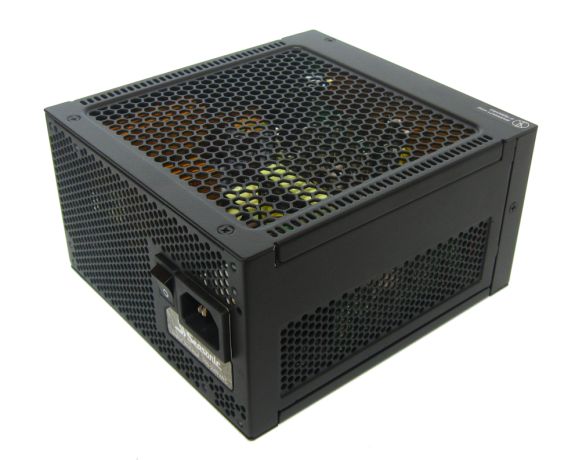
The casing for the SS-460FL has more ventilation holes than we're used to seeing, with perforations on practically every available spot! Besides the bottom (where a large fan might normally sit) and the back (to exhaust heat from your system), Seasonic has holes on the front and sides of the casing. Even the top (not shown, and assuming a top-mounted PSU; otherwise this is the "bottom") has a few extra holes to help with cooling. With no fan, there's obviously a need to remove heat and the extra ventilation should help in that regard. Of course, even a very slow fan would help a lot more, and perhaps a good CPU heatsink with a large, low-RPM 120mm fan is just what the doctor ordered. If you still want to be completely fanless, though, we'd exercise extreme caution before trying to stuff in 460W of components and other hardware!
Most of the honeycomb holes are over areas that radiate heat, like the holes over the secondary circuit attached to the back of the PCB. The casing is 16cm long, with a power switch on the rear of the unit. Modular cables attach to the front, and the overall build quality is very good.
Package Contents
Seasonic offers a few extras in the package to sweeten the deal. Besides the standard power cable and four screws, you get some stickers, a big user manual, and all the modular cables come in a bag. The "important notice" you can see above states that the PSU "is designed to be responsible for its own cooling". No more, no less.
The X-460FL has a fully-modular connection panel and a description for every plug-type. The main 24-pin cable uses two of the plugs (the large 18-pin connector, and the 6-pin connector next to it).
Rated at up to 456W, the +12V rail can deliver nearly the full power of the PSU. +3.3V and +5V are rated at a maximum capacity of 20A each, with a combined output of 100W. Like most modern high-efficiency power supplies, Seasonic has DC-to-DC converters inside.
Cables and Connectors
The 4+4 pin ATX12V, the 6-pin, as well as the 6/8-pin-PCIe connector are 65cm long, which is awesome for anyone with a larger computer case. The 24-pin motherboard connector is 60cm, which is also nice. Seasonic believes in their power ratings and they provide two PEG connectors for high-end graphic cards. A Molex-to-2x Floppy adapter (15cm) can optionally be connected to the peripheral cables if needed.
The first peripheral cable offers three SATA connectors from 55cm to 85cm in 15cm steps. Another harness provides two SATA connectors from 35cm. The same lengths are available for the two PATA cables. Unfortunately it is not possible to use the complete assortment of cables simultaneously; fill all the connections on the front of the PSU and you're still left with one harness.
Cable sleeving is also present, of the standard black mesh variety. It works well and provides a cleaner look than bare cables, and for a PSU in this price bracket it's expected. We've seen some better sleeving on competing PSUs, but unless you're really obsessed with internal wiring the sleeves get the job done.
| Cables and Connectors | ||
| Modular | Main | 24-pin 60cm |
| ATX12V/EPS12V | 4+4-pin 65cm | |
| PCIe | 1x 6-pin 65cm / 1x 6/8-pin 65cm | |
| Peripheral | 3x PATA 55-85cm / 2x PATA 35-50cm / 2x Floppy 15cm | |
| 3x SATA 55-85cm / 2x SATA 35-50cm | ||
Internals
Seasonic uses the same basic design as previous X-Series models, but there are some changes in the details. Of course, you don't need two main caps for reaching 460W and a long hold up time. A cap with 390µF is more than enough and Seasonic has chosen a nice Nippon Chemi-Con device; there are more Nippon Chemi-Con caps on the secondary side.
You can see the heatsink for the VRMs and larger ones for all the semiconductors. The inlet filtering is extensive as always and the PCB is placed near the entrance to get an improved electrical isolation. The fan regulation is completely removed and the PFC-controller now sits on a sister-PCB as a THT-component, but there are still many SMDs (Surface Mounted Devices). A PS223 offers the safety functions on the secondary side. including OCP.
Voltage Regulation
| +3.3V regulation | |
| Load | Voltage |
| 10% | 3.38V (+2.42%) |
| 20% | 3.37V (+2.12%) |
| 50% | 3.35V (+1.51%) |
| 80% | 3.33V (+0.91%) |
| 100% | 3.31V (+0.30%) |
| 110% | 3.30V (+-0%) |
| +5V regulation | |
| Load | Voltage |
| 10% | 5.03V (+0.60%) |
| 20% | 5.02V (+0.40%) |
| 50% | 5.00V (+-0%) |
| 80% | 4.97V (-0.60%) |
| 100% | 4.95V (-1.00%) |
| 110% | 4.94V (-1.2%) |
| +12V regulation | |
| Load | Voltage |
| 10% | 12.33V (+2.75%) |
| 20% | 12.30V (+2.50%) |
| 50% | 12.26V (+2.17%) |
| 80% | 12.22V (+1.83%) |
| 100% | 12.16V (+1.33%) |
| 110% | 12.12V (+1%) |
The voltage regulation is decent. There is hardly any drop on the +12 V rail, since its capacity is high. Even at overload the voltage is still 1 % above the nominal value. The other rails are within specification as well, which is expected on any decent PSU. +3.3V starts at 3.38V while the +5V is near the optimal value. At 50% load +5V is still at 5.00V and +3.3V never drops below 3.30V. This is simply an awesome result!
Efficiency and PFC
| 230VAC, 50Hz | ||
| Load | Efficiency | PFC |
| 10% | 81% | 0.917 |
| 20% | 87% | 0.970 |
| 50% | 91% | 0.986 |
| 80% | 91% | 0.990 |
| 100% | 91% | 0.993 |
| 110% | 91% | 0.994 |
| 115VAC, 60Hz | ||
| Load | Efficiency | PFC |
| 10% | 80% | 0.971 |
| 20% | 86% | 0.988 |
| 50% | 90% | 0.994 |
| 80% | 90% | 0.996 |
| 100% | 89% | 0.992 |
| 110% | 89% | 0.994 |
Considering the 80 Plus Gold certification, we expected high efficiency and that's exactly what we got. The efficiency is as high as the results from our X-750 test. The only blemish is that 10% load on what is essentially 850W design (fanless and down-rated at 460W) "only" comes in at 80%. At this point the efficiency could be better than 80%, but we're being picky. 46W output at 80% efficiency means power draw of 57.5W, where an 85% efficient design would save a whopping 3.5W and get you down to 54W power draw. For the vast majority of PCs that use 60W or more, efficiency will be higher, and loads of 50% to 110% are always above 89% on 115VAC—and up to 91.41% at 230 VAC! The power factor is impressive as well, measuring .97 or higher in every test (outside of 230VAC @ 10%).
Cooling and Noise Levels
| Sound Pressure Level | |
| Load | dB(A) |
| 10% | 0 |
| 20% | 0 |
| 50% | 0 |
| 80% | 0 |
| 100% | 0 |
| 110% | 0 |
Since there is no fan, there's not much point in measuring sound pressure levels, but what about noise from the electronics? There is nothing, no matter if there is a PC case between our ears and the PSU or not. No coil is singing, no capacitor is squealing, and we've got a dead silent PSU! Of course, we can't say whether the CPU, GPU, and motherboards will be up to the same task. Even conventional hard drives are "loud" by comparison, so silence enthusiasts will probably want to go the SSD route just to be sure.
| Temperature (Ambient/Exhaust) | |
| Load | (delta (t)) ° |
| 10% | 2 |
| 20% | 3 |
| 50% | 7 |
| 80% | 10 |
| 100% | 11 |
| 110% | 13 |
The difference between the ambient and the exhaust temperature is very low. We've tested the power supply with a room temperatur of 25 °C.
Ripple and Noise
The voltage quality is absolutely flawless. Small transients are no big deal and all the rails are always below 20mV ripple. +3.3V and +5V show no more than 12mV, and +12V is even better.
SS-460FL: Good and silent, but is that what you really want?
With a price of $160 online the Seasonic X-Series SS-460FL is as expensive as some previously tested 1000W power supplies. However, it offers the best performance we've seen and a fully modular connector panel. We've never seen a PSU that has no real weaknesses in our testing, and the worst thing we can say about the SS-460FL performance is that it only posted 80% efficiency at 10% load (which is still good).
We even managed to draw 110% of the rated output with reliable results, although it is difficult to assess what the performance will be after a few months of operation at high loads and the higher temperatures of summertime. If you're planning on running close to a 100% load with an entirely fanless system, we suspect you'll have difficulties, but provided you isolate the PSU from other heat sources it should hold up. Then again, finding fanless GPUs that require PEG connectors for power is hard to do, and that would almost be required to hit the 460W mark—that or a heavily overclocked CPU, neither of which would make much sense if you're after silent operation. Exercise some care in speccing out your system and err on the side of reason and the SS-460FL should perform admirably.
While you can't plug in all peripheral cable harnesses, the SS-460FL has two PCIe connectors—not bad for a passively cooled PSU. (Note that the 400W model only comes with a single PEG connector.) All of the cables are longer than 60cm as well, so you can safely use this unit in some larger cases. All the chosen components are upscale and the design and topology is outstanding. There is a line filtering stage (Yunpen) behind the entrance and Nippon Chemi-Con capacitors are used throughout the PSU. The Infineon transistors are well dimensioned and the attachement of the PFC-choke is adequate. And just in case something goes awry, Seasonic offers all the expected safety functions.
The SS-460FL reached up to 91% efficiency, with no more than 12mV ripple and noise on all rails and good voltage regulation. There's no fan to make noise, and the electronics are also free of static or any other unwanted effects. The PSU is exactly what you'd expect: silent. Even so, there's some serious competition for the X-Series Fanless models from Seasonic's own product line.
The semi-passive X-Series models are able to deliver more power, thanks to the addition of active cooling that kicks in at around 20% load and only really becomes noticeable above 50%, and you get all that for the same (or a lower) price. This includes the SS-560KM, which bumps up the maximum output and can still run silently under light loads, or near-silent at moderate loads. Considering you can get that unit for $30 less than the SS-460SL, and the peace of mind the "backup" Sanyo Denki fan provides, for the vast majority of users we'd recommend that route over a fanless PSU.
If you want to have an absolutely silent PSU that can run at high loads and you don't care about cost, the SS-460FL delivers. What we can't readily quantify is the long-term stability and performance after months or years of use. The SS-460GL is a prestige object that most will find unnecessary, but it's still an awesome product. For all other customers the SS-560KM is nearly silent through ~50% load and passive at low loads, and it represents a more reasonable selection for midrange PCs. After all, why bother with a silent PSU if you're still running fans on the CPU and GPU?

